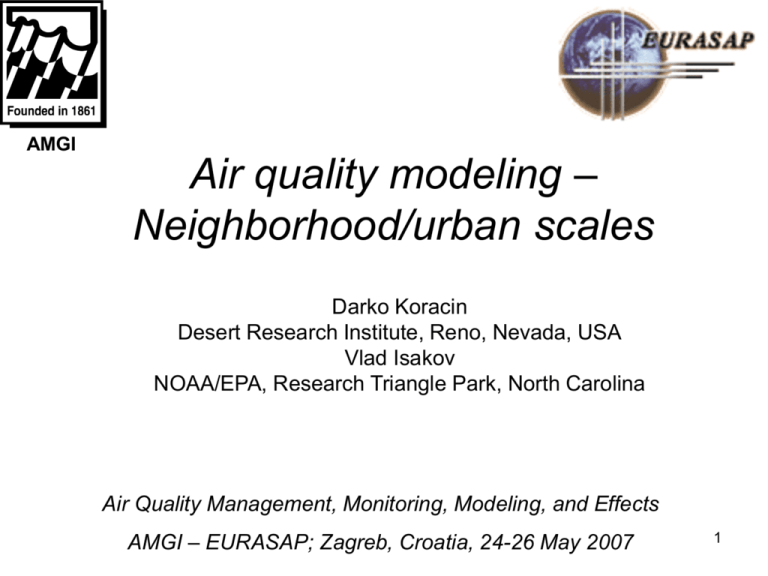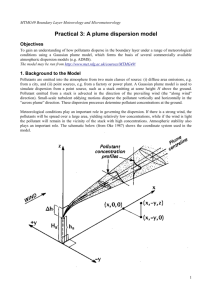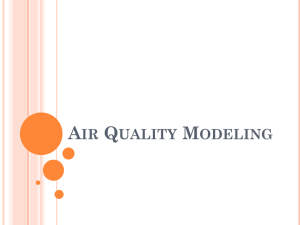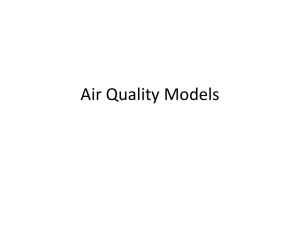07 - Urban Neighborhood Modeling
advertisement

AMGI Air quality modeling – Neighborhood/urban scales Darko Koracin Desert Research Institute, Reno, Nevada, USA Vlad Isakov NOAA/EPA, Research Triangle Park, North Carolina Air Quality Management, Monitoring, Modeling, and Effects AMGI – EURASAP; Zagreb, Croatia, 24-26 May 2007 1 Land-use Air Quality Model Meteorology Emissions Air Pollutant Concentrations 2 Main concepts in air quality modeling 3 Air Quality Modeling • Meteorological Models – Provide input meteorology for dispersion and photochemical models. • Dispersion Models - These models are typically used in the permitting process to estimate the concentration of pollutants at specified ground-level receptors surrounding an emissions source. • Photochemical Models - These models are typically used in regulatory or policy assessments to simulate the impacts from all sources by estimating pollutant concentrations and deposition of both inert and chemically reactive pollutants over large spatial scales. • Receptor Models - These models are observational techniques which use the chemical and physical characteristics of gases and particles measured at source and receptor to both identify the presence of and to quantify source contributions to receptor concentrations. 4 Air Quality Model Land-use Climate Change Meteorology Air Quality Emissions Health 5 Spatial scales and relevant pollutants • Microscale (10 to 100 m) and Middle-scale (100 to 500 m) – odors, dust, traffic, hazardous pollutants. • Neighborhood scale (500 m to 4 km) – vehicle exhaust, residential heating and burning, primary industrial emissions. • Urban scale (4 to 100 km) – ozone, secondary sulfates and nitrates, forest fires, regional haze. • Continental scale (1,000 to 10,000 km) – Asian and Saharan dust, large scale fires. • Global scale (> 10,000 km) – greenhouse gases, halocarbons, black carbon. 6 The simplest dispersion modeling – Gaussian approximation for the plume spread Not applicable to regional scales – complex terrain, convective conditions, and ground-level sources. 7 Limitations of Gaussian-plume models • Causality effects Gaussian-plume models assume pollutant material is transported in a straight line instantly (like a beam of light) to receptors that may be several hours or more in transport time away from the source. • Low wind speeds Gaussian-plume models 'break down' during low wind speed or calm conditions due to the inverse wind speed dependence of the steady-state plume equation, and this limits their application. • Straight-line trajectories In moderate terrain areas, these models will typically overestimate terrain impingement effects during stable conditions because they do not account for turning or rising wind caused by the terrain itself. CTDM and SCREEN are designed to address this issue. • Spatially uniform meteorological conditions Gaussian steady-state models have to assume that the atmosphere is uniform across the entire modelling domain, and that transport and dispersion conditions exist unchanged long enough for the material to reach the receptor. • Convective conditions are one example of a non-uniform meteorological state that Gaussianplume models cannot emulate. • No memory of previous hour's emissions In calculating each hour's ground-level concentration the plume model has no memory of the contaminants released during the previous hour(s). 8 Advanced dispersion models (I) • Puff models Pollutant releases can also be represented by a series of puffs of material which are also transported by the model winds. Each puff represents a discrete amount of pollution, whose volume increases due to turbulent mixing. Puff models are far less computationally expensive than particle models, but are not as realistic in their description of the pollutant distribution. • Eulerian grid models Pollutant distributions are represented by concentrations on a (regular) threedimensional grid of points. Difficulties arise when the scale of the pollutant release is smaller than the grid point spacing. The simulation of chemical transformations is most straightforward in a Eulerian grid model. • Lagrangian particles Pollutant releases, especially those from point sources, are often represented by a stream of particles (even if the pollutant is a gas), which are transported by the model winds and diffuse randomly according to the model turbulence. Particle models are computationally expensive, needing about millions or so particles to represent a pollutant release, but may be the best type to represent pollutant concentrations close to the source. 9 Lagrangian particle dispersion models Puff models Eulerian Chemical Model: o-1 3 4 2 1 8 o-3 7 9 [O 3] [NO 2] o-2 5 6 o-4 [NO] [VOC] [HN 4NO3 ] ... o-1 3 4 2 1 8 o-3 o-2 6 7 o-4 9 o-6 o-5 5 •Chemical transformations will be made on a Eularian grid. •Enables interactions between emissions from different sources. •Includes gas and aqueous phase chemistry and secondary aerosol formation. 10 However, real conditions are quite complex. First: Need to know wind aloft – virtually no continuous measurements Complex horizontal, vertical, and temporal wind structure 11 Next: In most of cases we are not dealing with flat terrain – topographic complexity Complex horizontal, vertical, and temporal dispersion 12 Next: Topographic complexity induces local flows and circulations Complex horizontal, vertical, and temporal dispersion 13 Building downwash for two identical plumes emitted at different locations The stack on the left is located on top of a building and this structure impacts on the wind-flow which, in turn, impacts upon the plume dispersion, pulling it down into the cavity zone behind the building. The stack on the right is located far enough downwind of the building to be unaffected by the wake effects14and is not as dispersed in the near field. Next: Interaction between plumes of different buoyancy and an inversion layer Complex horizontal, vertical, and temporal dispersion 15 Sea and land breezes (Left): The sea breeze where the air flows from the ocean towards the warm land during the day with warmed air from above the land recirculating back over the ocean. (Right): The land breeze at night where cool air drifts from the land towards the ocean, where it is warmed and recirculated back 16 over the land. Transport and dispersion of inert chemical tracers in a coastal urban region Example • To examine the extent to which Mesoscale Model (MM5) and a Lagrangian Random Particle (LAP) Model can be used for studies of atmospheric transport and dispersion on a sub-kilometer scale. • Environmental Justice (?) 17 Geographical setup – Western U.S. – Southern California 18 Mesoscale Model 5 (MM5) Overview • Limited-area nonhydrostatic, terrain-following sigma-coordinate model for simulations or forecasts of mesoscale and regional-scale circulations. • Continuous development since the early 70’s (Penn State & NCAR). • Community model – more than 100 registered users worldwide (universities, government, private enterprise). • More than 200 peer-reviewed publications focusing on model development, evaluation, and applications. • Web page: http://www.mmm.ucar.edu/mm5 19 MM5 Overview – Main features • Prognostic equations for: – U (west-east), V (southnorth), W (vertical) wind components – Temperature – Humidity – Pressure – Turbulence kinetic energy • Multiple model domains (nests). • Nonhydrostatic dynamics allow high horizontal resolutions (1 km or less). • Multi-tasking capability on shared- and distributedmemory machines. • Four-dimensional data assimilation capability. • Advanced options for physical parameterizations 20 Field program • Tracer experiment conducted in August 2001 in the SE San Diego area - Bario Logan. • SF6 tracer released during daytime (10am to 7pm) on 21, 23, 25, 29, and 31 August. • Tracer sampling stations - 50 locations arranged in four arcs (250 m, 500m, 1km, and 2km). • Additional meteorological measurements acoustic sounder (range at 200m, resolution 5m); six sonic anemometers (surface winds 21 and turbulence). Map of Barrio Logan - tracer experiment, August 2001 BL school: 5 sonics, mini-sodar NASSCO: tracer release, sonic (roof) 22 Concept of the tracer experiment • Tracer was released over the land near the shore during daytime (10am to 7pm) with prevailing sea breeze (onshore flow). • The tracer sampling stations were arranged in four arcs to assure plume sampling during the onshore flow. • Tracer emission rate was generally constant at about 5 g/s. • Tracer concentrations were averaged hourly. 23 Microscale Tracer Experiment at Barrio Logan 24 Meteorological model (MM5) setup Setup of the MM5 modeling domains with horizontal resolutions of 12 km (D01), 4 km (D02), 1.333 km (D03), and 0.444 km (D04). 25 MM5 provides meteorological input (winds, stability, turbulence) to a dispersion model MM5(20m) vs. SODAR(20m) and Surface st.(4m) validation (I) Time series – “U” (west-east) wind component 26 Lagrangian Random Particle (LAP) Dispersion Model - Main principles • Numerical model which uses a large number of hypothetical particles to simulate the transport and dispersion of atmospheric pollutants. • Particles are subjected to 3D atmospheric fields. • Dispersion of the simulated plume is directly linked to the turbulence structure without the Gaussian assumption. • Typically, 500 particles per minute are emitted from each source. • The particles are continuously traced in time and space and their population represents the plume structure. Koracin et al. 2007 (Atmospheric Environment) 27 Complexity of plume(s) Simulated and measured hourly concentrations (ppt) at each of the 50 receptors at a particular hour. 28 Complexity of plume(s) Frequency distribution Simulated and measured hourly SF6 concentrations (ppt) at all 50 receptors at all times. 29 San Diego – 23 Aug 2001 Measured concentrations Simulated concentrations 30 Top-view of distribution of particles – San Diego harbor 1 km horizontal resolution 444 m horizontal resolution Meteorology: MM5 model; Dispersion: Lagrangian Random Particle Dispersion Model 31 Summary and concluding remarks • Small-scale transport and dispersion of tracers in coastal urban conditions represents a significant challenge for modeling. • 50 receptors were located in four arcs within the 2.5 x 2.5 km area. • SF6 tracer was released during daytime with on-shore wind conditions. • Inhomogeneous (non-Gaussian) structure of the plume(s) was observed /complexity of 32 meteorology & dispersion/. Dispersion driven by models and/or measurements DRI – MM5 real-time weather forecasting Emission input (tracer, pollutants, etc.) Lagrangian random particle dispersion model Individual element of the plume Synoptic forecast input 1 now Source Source Winds and turbulence determine position at each time step before The composition of the individual elements makes the plume Model simulations: 3D transport and dispersion of the plume Measurements only input 2 Plume: NTS – 13 July 2005 – 1500 PDT Measurement input dispersion simulations Mobile sodar – RASS measurement system Synoptic input dispersion simulations 33 34







